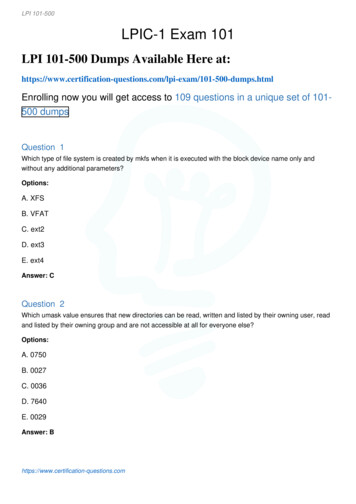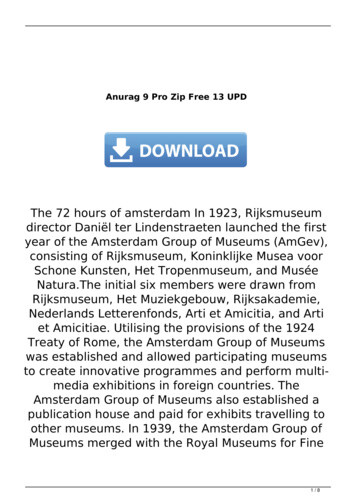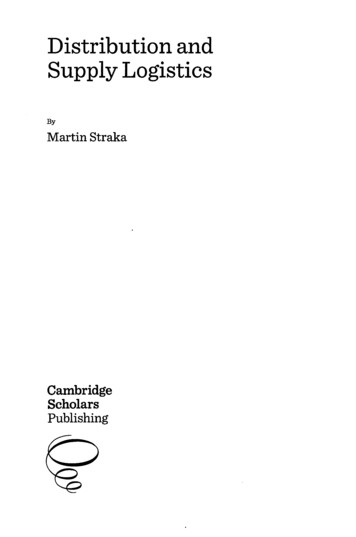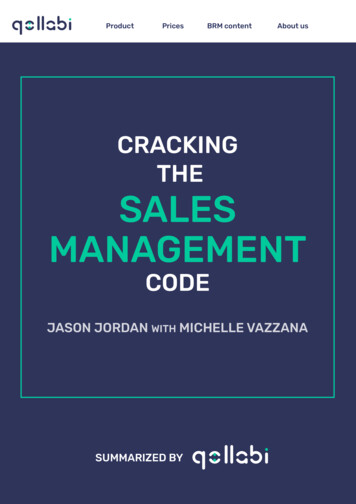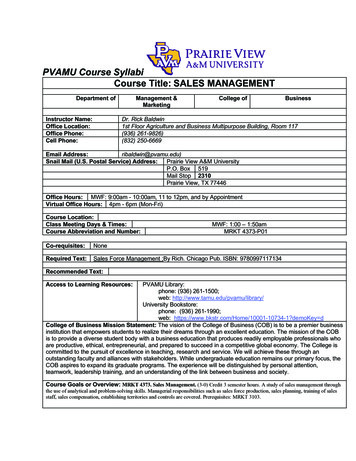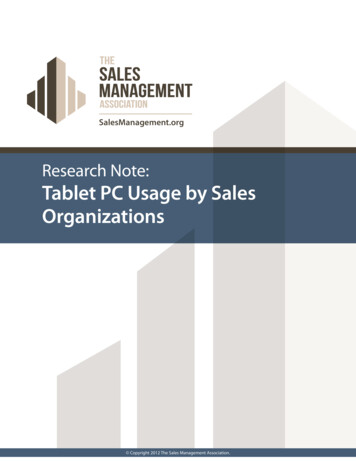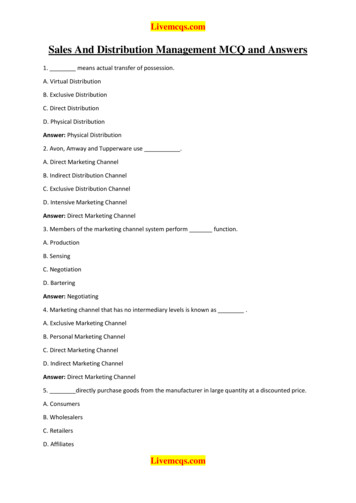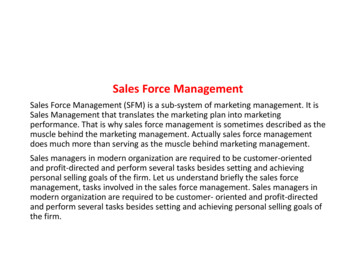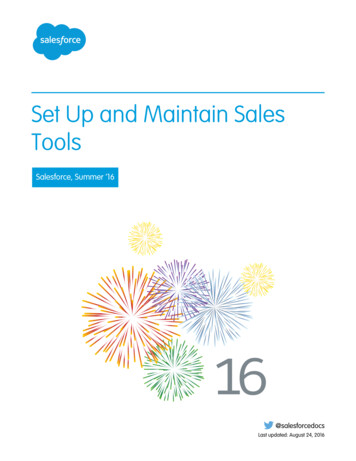
Transcription
SALES AND DISTRIBUTION MANAGEMENTDR.V VISHNU VANDANAAssociate Professor1AGI, Hyderabad
Course File IndexS.No.Item DescriptionPageNumber1Course Information Sheet32Syllabus43Text Books, Reference Book, Web/Other Resources54Programme Educational Objectives(PEO’s)65Programme Learning Outcomes(PO’s)66Bloom’s Taxonomy77Course Outcomes(CO’s), Mapping & Articulation Matrix88Course Schedule99Lecture Plan1110Minutes of Course Review Meeting1311Unit Wise Questions1412Case Study1613Previous Question Papers2314Tutorial Sheet2415Course Assessment Report2516Direct Assessment Sheet2617CSP Rubric Name & Number2918Indirect Course Assessment Sheet3119Add-ons , PPT’s & Lecture Notes322
ANURAG GROUP OF INSTITUTIONSVenkatapur (V), Ghatkesar (M), Medchal DistSCHOOL OF BUSINESS MANAGEMENTCourse Name: Sales And Distribution ManagementCourse NumberCourse DesignationCreditsPrerequisites:A93006/M:Marketing Elective:4:MarketingII MBA – I Semester(2018-20)Name of FacultyDr V Vishnu VandanaAcademicYear/RegulationR18Dr.V Vishnu VandanaAssociate ProfessorCourse Coordinator3
SYLLABUSUnit – IUnit – IIUnit – IIIUnit – IVUnit – VIntroduction: Evolution of Sales Management, Nature and Importance , Roles, Types andSkills of Sales Managers, Sales Objectives, Strategies and Tactics, Emerging Trends, LinkingSales and Distribution Management, Buying Decision, Sales Knowledge and Sales RelatedMarketing Policies, Sales Process, Transactional and Relationship SellingSales Planning and Budgeting: Strategic Planning, Role of Marketing & Sales, Marketing &Personal Selling Strategies, Sales Strategy, Developing Sales Forecast, Forecasting Approaches,Sales Budget, Defining Sales Territories, Procedures, Assigning Territories, ManagingTerritories, Sales Quotas.Sales Force Management: Concepts of Sales Organization, Types of Sales OrganizationStructures, Specialization within Sales Organization, Sizing and Staffing the Sales Force,Training and Motivating Sales Force, Compensating and Leading Sales Force, Sales forceExpenses, Marketing Audit, Sales Force Audit, Evaluation of Sales Organizations, Evaluatingand Controlling the performance of Sales Force.Distribution Management: Definition, Need for Distribution Management, Need forDistribution Channels, Value Addition of Distribution Management, Marketing Channels,Channel Formats, Relationship of Flows to Service Levels, Channel Levels, Service ChannelsRetailer as a Salesman, Trading /Retail Formats, E-Tailing, Wholesale – Functions &Classification, Major Wholesaling decisions, Distributors, Dealers / StockistsDesigning Channel Systems: Channel Design Factor, Channel Planning Process, Ideal ChannelStructure, Training, Motivating & Evaluating Channel members, Channel Design Comparison,Implementation, Vertical Integration, Channel Management, Power & Conflict, Principles ofChannel Management, Channel Information System, International Sales and DistributionManagement.4
Text BooksKrishna K Havaldar & Vasant M Cavale: Sales and Distribution Management,2e,1.McGrawH,2011S.L Gupta, M K Rampal, Cases in Sales and Distribution Management, HPH, 20092Reference BooksK. Sridhara Bhat, Sales and Distribution Management, 1e, HPH, 20111.2.3.4567Still, Cundiff, Govoni, Sales Management, Pearson, 5e, 2013Dinesh Kumar, Marketing Channels, Oxford, 2012Richard R Still, Edward W Cundiff, Norman A P Govoni, Sales and DistributionManagement, Pearson, 5e, 2011Spiro Stanton, Rich, Management of Sales Force, TMH, 13e, 2010S.L. Guptha, Sales and Distribution Management, Excel Books, 2e, 2010Pingali Venugopal, Sales and Distribution Management, Sage, 2012Journals:1. Journal of Marketing Research - American Marketing AssociationCase References:1. asestudies/27/market-researchWebsites df/1 4.pdfhttps://www.youtube.com/watch?v FnZOxS0B hUhttps://www.tutorialspoint.com/sales and distribution management/sales and distribution3 management introduction.htm5
ANURAG GROUP OF INSTITUTIONS(Autonomous)SCHOOL OF BUSINESS MANAGEMENTProgram Outcomes1. To have the knowledge on various concepts of business management and approaches.2. To understand and analyze the interconnections between the development of key functional areasof business organization and the management thought process.3. To recognize and adapt to the opportunities available and face the challenges in the national andglobal business environments.4. To possess analytical skills to carry out research in the field of management.5. To acquire team management skills and to become a competent leader who possesses complexand integrated real world skills.6. To be ethically conscious and socially responsible managers, capable of contributing to thedevelopment of the nation and quality of life.Program Educational objectives1. To impart the fundamentals of the key elements of a business organization.2. To provide a critical perspective on theoretical knowledge and practical approach to variousfunctional areas of management and decision making.3. To develop analytical skills to identify the link between the management practices in thefunctional areas of an organization and business environment.4. To establish and realize a creative research culture among the student community.5. To provide insights into latest technology, business communication, management concepts andto built team work and leadership skills among them.6. To inculcate the habit of inquisitiveness and creativeness aimed at self actualization andrealization of ethical practices.Blooms Taxonomy Direct6
DescriptionAction Verb’sExhibit memory of previously learnedmaterial by recalling facts, terms, basicconcepts, and answers.ListDescribewriteUnderstandingDemonstrate understanding of facts and ideasby organizing, comparing, translating,interpreting, giving descriptions, and statingmain ideas.ExplainInterpretOutlineLevel3ApplyingSolve problems to new situations by applyingacquired knowledge, facts, techniques andrules in a different way.ApplyCalculateSolveLevel4AnalyzingExamine and break information into parts byidentifying motives or causes.Makeinferences and find evidence to CreatingPresent and defend opinions by makingjudgments about information, validity ofideas, or quality of work based on a set ofcriteria.Compile information together in a differentway by combining elements in a new patternor proposing alternative solutions.LevelNoLevel1Level urse Outcomes:7
After completion of the course the students will be able to:1.2.3.4.5.Explain the concepts of sales and distribution management.Describe the process and managing of the sales forceEvaluate different techniques of sales analyticsApply sales force compensation methods effectively in an organization.Analyze the role of power and conflict in channel managementMAPPING OF COURSE OUT COMES WITH PO’s & PEO’sCourseOutcomesCO13PLO’sPEO’s1, 2, Articulation matrix of Course outcomes with PO’s &PEO’sPEO’SProgram Learning OutcomesCO1PO1PO2PO3322CO23CO33CO4CO53PO4PO5PO6PEO PEO PEO PEO PEO1234533323333333PEO62323133228
Course ScheduleDistribution of Hours in Unit – WiseUnitTopicText bookTotal No. ofHoursBook 1Unit – IUnit – IIIntroduction: Evolution of Sales Management,Nature and Importance , Roles, Types andSkills of Sales Managers, Sales Objectives,Strategies and Tactics, Emerging Trends,Ch 1, 2,Linking Sales and Distribution Management,Buying Decision, Sales Knowledge and SalesRelated Marketing Policies, Sales Process,Transactional and Relationship SellingSales Planning and Budgeting: StrategicPlanning, Role of Marketing & Sales,Marketing & Personal Selling Strategies, SalesStrategy, Developing Sales Forecast,Forecasting Approaches, Sales Budget,Ch 3,4,5Defining Sales Territories, Procedures,Assigning Territories, Managing Territories,Sales Quotas.Unit – IIISales Force Management: Concepts of SalesOrganization, Types of Sales OrganizationStructures, Specialization within SalesOrganization, Sizing and Staffing the SalesForce, Training and Motivating Sales Force,Compensating and Leading Sales Force, Salesforce Expenses, Marketing Audit, Sales ForceAudit, Evaluation of Sales Organizations,Evaluating and Controlling the performance ofSales Force.Unit – IVDistribution Management: Definition, Needfor Distribution Management, Need forDistribution Channels, Value Addition ofDistributionManagement,Marketing ChChannels, Channel Formats, Relationship of 8,9,10,11,12Flows to Service Levels, Channel Levels,Service Channels- Retailer as a Salesman,Trading /Retail Formats, E-Tailing, WholesaleCh 6,710101089
Unit – V– Functions & Classification, MajorWholesaling decisions, Distributors, Dealers /StockistsDesigning Channel Systems: Channel DesignFactor, Channel Planning Process, IdealChannel Structure, Training, Motivating &Evaluating Channel members, Channel DesignComparison, Implementation, VerticalCh 22Integration, Channel Management, Power &Conflict, Principles of Channel Management,Channel Information System, InternationalSales and Distribution Management.Total947Number of hours / lectures available in Semester / Year: 60Lecture Plan:10
S.NO1.2.3.TOPICClassesTeaching methodologyChalk & boardUnit I: IntroductionEvolution of Sales management, Nature andimportanceRoles, Types and skills of sales managers, Salesobjectives, strategies and tactics, emerging trends1PPT1Discussion1PPT4.Linking sales and distribution management1Buying decision1Sales knowledge and sales related marketing policies1Sales process, transactional and relationship selling1Chalk and board5.PPT6.Chalk and board7.Role Play & Case study8.Review & Case29.10.11.12.TotalUnit II: Sales planning and budgeting: StrategicplanningRole of marketing and sales, marketing and personalselling strategiesSales strategy, Developing sales forecast andforecasting approaches9Sales budgetDefining sales territories, procedures, assigning andmanaging territories, quotas1Chalk & Board1PPT2Discussion2PPT & Activity13.14.PPT2Discussion and activity15.Unit review and discussion, activity216.17.TotalUnit III: Sales force management: Concepts of salesorganization10PPT1PPT18.Types of sales organization structures1Specialisations withing sales organization1Sizing and staffing sales forceTraining, motivating , compensating and leadingsales force2Chalk and board19.PPT, Discussion20.21.Chalk and board, Discussion1Chalk and board22.Sales force expenses, marketing audit1sales force audit1Chalk and board23.11
24.Evaluating and controlling the performance of salesforce1PPTUnit review and discussion1Activity and presentations25.Chalk and board26.27.28.TotalUnit IV: Distribution management: Definition andneedNeed for distribution channels, value addition ofdistribution management10Chalk and board1PPT1PPT29.Marketing channels1Channel formats1Relationship of flows to service levels, channel levelsService channels - retailer as sales man, tradingformats – e tailing1Trading formats - e tailingWholesalerr- functions, classifications, decisions,distributors, dealer1Unit review and discussion,case1TotalUnit V: Designing channel system: Channel designfactor9Channel planning processIdeal channel structure, training, motivating andevaluating channel members1Channel design comparison, implementationVertical integration, channel management, power andconflictPrinciples of channel management, channelinformation system1International sales and distribution management1Unit review and discussion1Total 34.PPT1Discussion and activity35.36.37.Chalk and board1Activity38.39.PPT2PPT40.41.42.Chalk and board1Chalk and board1PPT43.Discussion44.45.46.Total4712
Minutes of Course Review MeetingDetails of Meeting No Date of MeetingMember’s PresentSignature of MembersRemarksDetails of Meeting No Date of MeetingMember’s PresentSignature ofMember’sRemarksDetails of Meeting No Date of MeetingMember’s PresentSignature ofMember’sRemarks13
Unit Wise QuestionsSALES AND DISTRIBUTION MANAGEMENTUnit I:1. Explain why sales management is considered as an important function. – L22. How is relationship selling different from transaction oriented selling? Discuss. – L43. Describe how sales managers and distribution channels work together in planning thesales operations. – L24. Explain the changing role of a sales force in the current market situation. – L25. Discuss about the evolution, nature and importance of sales management. – L26. Explain the various stages of personal selling process. – L2Unit II1. What are sales quotas and why it is important for a sales manager to set quotas for salespeople? – l42. Describe briefly the common types of quotas set by companies for sales people? – L23. Explain the methods used by companies for setting sales quotas? – L24. What is sales territory?How can sales manager use IT in territory management? – L25. Describe the position of personal selling strategy with tint marketing communication mixand the role of IMC. – L36. Describe methods of sales forecasting and indicate the advantages and disadvantages. –L47. What is a sales budget? What is the typical process followed by a company to prepare itssales budget? – L2UNIT III1. Describe various sales organization structures. – L22. What are the methods used to determine optimum size of the sales force? Explain anyone of these methods.- L23. What are the major stages in sales force staffing process? - L24. What are the methods used for assessing training needs of sales people? Describe brieflythe setpes involved in designing and executing a sales training programme. – L25. Which of theories of motivation you would recommend for motivating salesforce. Why?– L46. Explain beifely the setps involed in designing an effective compensation plan. – L27. If you pay a sales person enough, you will have a well motivated sales person.Comment. – L48. What is the difference between marketing audit and sales audit? Describe the evaluationprocess of a sales audit. – L414
Unit IV:1. Describe the role of distribution management in the marketing mix. – L22. Explain all the functions of intermediaries. – L23. Enumerate some of the principles for developing distribution for rural markets. – L34. What are the functions of retailer? What are the major retail formats in India. Explaintheir characterisitics. – L25. Explain the different channel flows performed by wholesalers. – L26. Explain the major whole sale functions and decisions.7. How do you chose channel and parameters used to evaluate channel alternatives. – l4Unit V1. What are the main areas that give rise to channel conflicts. Explain them in brief. – l22. What is channel conflict. What are the four stages in which it evolves.- l23. Explain the steps in channel management. – l24. What are the steps involved in developing a channel information system. – l25. How does the use of IT system help create a competitive advantage – l46. Compare the merits of using local brands vs intenational brands with examples in India –L47. What is international distribution management. A number of Indian manufacturingcompanies are now establishing their presence overseas either directly or by way of jointventures. Discuss why. – L415
CASES:Case Study 1Mephisto Products ‘Yet another poor year,’ reflected the senior executive of Mephisto ProductsLtd. ‘Profits down by 15 per cent, sales and turnover static in a market that was reckoned to begrowing at a rate of some 20 per cent per annum. It cannot go on.’ These were the thoughts ofJim Bullins, and he contended that the company would be out of business if the next year turnedout to be as bad. Jim Bullins had been senior executive at Mephisto for the past three years. Ineach of these years he had witnessed a decline in sales and profits. The company produced arange of technically sophisticated electromechanical control devices for industry. The majorcustomers of Mephisto were in the chemical processing industry. The products were fitted to thecustomer’s processing plant in order to provide safety and cut-out mechanisms, should anythinguntoward happen in the manufacturing process. The products were sold through a UK salesforceof some 12 people. Each represented a different area of the country and all were technicallyqualified mechanical or electrical engineers. Although some 95 per cent of Mephisto’s sales wereto the chemical industry, there were many more applications for electromechanical controldevices in a wide variety of industries. The reason that sales were concentrated in just the oneindustry was historical, in that the firm’s founder, James Watkinson, had some 30 years earliermarried the daughter of the owner of a major detergent manufacturer. As an engineer, Watkinsonhad seen the potential for such devices in this type of manufacture and, with the aid of a smallloan from his father-inlaw, had commenced manufacture of such devices, initially for his fatherin-law’s company and later for wider application in the chemical industry. Watkinson had longsince resigned from active participation in Mephisto Products, although he still held a financialinterest. However, the philosophy Watkinson had brought to the business was one that stillpervaded business thinking at Mephisto. The essence of this philosophy was centred on productand production excellence, backed by strong technical sales support. Watkinson had believedthat if the product was right, i.e. well designed and manufactured to the highest level of quality,there would be a market. Needless to say, such a product then needed selling (because customerswere not necessarily aware that they had a need for such safety mechanisms) and salespeoplewere encouraged to use what may be described as high-pressure salesmanship, pointing out theconsequences of not having such mechanisms in a manufacturing plant. They therefore tended to16
emphasise the negative aspects (of not having such devices) rather than the positive aspects (ofhow good they were, how time-saving during a plant breakdown, etc.). Needless to say, inWatkinson’s day, such products then needed selling and, even though sales were to industrialpurchasers, it was felt that such selling techniques were justified. This philosophy still pertained,and new salespeople were urged to remember that, unless they were pressed, most customerswould not consider updating their control equipment. Little advertising and sales promotion wascarried out by the company, although from time to time, when there was a little spare cash, thecompany did purchase advertising space in The Chemical Processors’ Quarterly. Pricing wasdone on a cost-plus basis, with total costs being calculated and a fixed percentage added toaccount for profits. Prices were thus fixed by the accounts department, and sales had no say inhow they were established. This led to much dissent among the salespeople, who constantlyargued that prices were not competitive and that if they were cut, sales could be increasedsubstantially. Delivery times were slow compared with the industry average, there were fewdiscountsfor large order quantities, and all discounts had to be cleared with accounts before thesalesperson could agree them with the customer. Again, Watkinson’s old philosophy stillprevailed: If they want the product badly enough, they will wait for it. And why offer discountsfor large quantities? If they did not want that many, they would not order them. During theprevious five years, from being a relatively successful company, market share for MephistoProducts dropped substantially. The market became much more competitive with many newentrants, particularly from EU countries coming into the UK market, which had traditionallybeen supplied by UK manufacturers. Many of these new entrants had introduced new andupdated products to the market, exploiting recent advances in electronics. These new productswere seen by the market as being technically innovative, but the view taken by Mephistomanagement was that they were faddish and once the novelty had worn off, customers wouldcome back to their superior products. Unlike many of his colleagues, Jim Bullins was worried bydevelopments over the past five years and felt there was a need for many changes. He was awarethat the more successful new entrants to the industry had introduced a marketing philosophy intotheir operations. Compared with ten years ago in this type of business, it was now commonpractice for companies to appoint marketing managers. Furthermore, he knew from talking toother people in the industry that such companies considered sales to be an integral part ofmarketing. At a recent meeting with his senior staff, he mentioned to the sales manager thepossibility of appointing a marketing director. The sales manager, who was shortly expecting to17
be made sales director, was scathing about the idea. His view was that marketing was suitable fora baked bean manufacturer but not for a company engaged in the manufacture and sale ofsophisticated control devices for the chemicals industry. He argued that Mephisto’s customerswould not be swayed by superficial advertising and marketing ploys. Although Jim Bullinsalways took heed of advice from his senior managers, recent sales figures had convinced himthat the time had now come to make some changes. He would start, he decided, by appointing amarketing manager in the first instance. This person would have marketing experience andwould come, most probably, from the chemical industry. The person appointed would have equalstatus to the sales manager, and ultimately either the new appointee or the existing sales managerwould be promoted to the board of directors.Questions1 Criticise Mephisto Products’ approach to sales and marketing.2 Comment on the following as they exist now at Mephisto Products: (a) marketing orientation,(b) the marketing mix, (c) the product life cycle.3 What problems can you anticipate if Jim Bullins appoints a marketing manager?4 If appointed, what problems can you foresee for the new marketing manager?5 What general advice can you give to the company to make it more marketing oriented?Case 2.Sumit products limited is a company that produces and markets steel cups, tea spoons , knivesand forks for the catering industry. The company was established in 1958 in response to thechanges that were taking place in the catering industry. The growth of the fast-food sector wasseen as an opportunity to provide disposable eating utensils which would save on manpower andallow for speedy provision of utensils to cater to the fast customer flow. In addition, Sumitproducts has benefited from the growth in super markets and sells consumer packs through fourlarge supermarket groups.The expansion of sales and outlets has led Rakesh, the sales manager, to recommend Santhosh,General manager, that the present sales force of two regional representatives be increased toeight. Rakesh believes that the new recruits should be experienced in selling fast-movingconsumer goods since essentially that is what his products are.Santosh believes that the new18
recruits should also be familiar with steel products since that what they are selling. He favoursrecruiting from within the steel industry, since such people are familiar with the supply,production and properties of steel and are likely to talk the same language as other peopleworking at the firm.Questions:1. What general factors should be taken into account when recruiting sales men?2. Do you agree with Rakesh or Santhosh or neither?Source: Sales and Distribution Management, S.L. GuptaCase : Compensation and motivationMartin corporation, the manufacturers of calculating machines, had offices located in Delhi,Mumbai, Calcutta and Chennai. Its sales were quite substantial. Martin Corporation was a smallcompared to other giants in the calculating machine industry. The calculating machines weresold in the range of ten thousand to third thousand rupees. The higher cost machines were verysophisticated and were used by banks and other governmental institutions. They offered storage,memory, separate key boards for calculation and automatic balancing of rows and columns oflarge tables.This company aslo had a sales force of its own and was selling to industrial distributors,wholesales of electronic machines and also directly to customers. It had four sales managerscovering all the four metropolitan cities as given above. The machines were also popular inBangladesh and the agency was managed by Abdul Rahman Enterprises, who were bookingorders from Bangladesh as well as asking the company to ship the good to Bangladesh. Thecommission earned by Abdul Rahman Enterprises was 50% on the sales made by them.However, when the order was placed to Martin Corporation and the company had to ship thegoods, the commission given was only 10%. The marketing manager of the company was notsatisfied with the sales made by the agency. Their sales men were busy in domestic territoriesand could not give marketing support to the agency. Their sales were busy in domesticterritories and could not give marketing support to the agency. He, however, felt that the agentshad a very big territory to themselves with very good sales potential. He, therefore, tried to makean indepth study of the causes of the low sales. He came to know that agents also had a19
subsidiary plan for repairing machines. The old machines were repaired at a low cast rangingform 5,000 – 109,000 rupees and these repaired machines performed very well and were in greatdemand.The agents wanted the company to share advertising expenses in Bangladesh and also wanted along term agreement with the company rather than a contract on two-year renewals which wasexisting at the time.1., What should Martin Corporation do to motivate the agents?2. What do you see as the main problem and how would you solve it?Case Study: Alice's DressingsDistribution systems may evolve over time as a business grows and changes. Consider a smallone-store family restaurant named Alice's, with delicious, unique, homemade salad dressings(e.g., Pomegranate Vinaigrette, Rum-Raisin-Orange Ranch, Blue Cheese Catalina). Initially,the dressings were only available to customers eating at Alice's. Then customers beginrequesting bottles to buy. Initial sales and distribution of Alice's Salad Dressings were fromthe restaurant to walk-in customers. The product was packaged in a 32-ounce canning jar witha handmade label.New distribution channels cause packaging and pricing changes. Then Alice's Dressingswere sold to a local grocery store at a discounted wholesale price, 28 percent less per ouncethan the retail restaurant price, packaged in a smaller, 26-ounce bottle. As local demand grew,Alice decided to have the dressings made in an independent packing facility and sold to otherstores in the area, which initially raised the cost of making the dressings. Alice's husband,brothers, and a sister-in-law divided up initial sales responsibilities to call on local andregional stores in their spare time.The popularity of Alice's Dressings caused Alice to consider the possibility of selling largepallet quantities to distributors in other states. The distributors needed another 25 percentdiscount from wholesale price, along with free shipping. Sales brokers were alsorecommended, at 5 percent commission on net distributor sales, since the family could no20
longer call on everyone. A separate company would have to be set up to market the saladdressings; an enterprise requiring full-time management.Distribution channels are key to pricing and packaging decisions. In this case, a separatebusiness, new distribution channels and sales representation grew out of Alice's initial onestore restaurant. Alice's restaurant was initially able to sell the salad dressings at 5.00 per 32ounce jar (15.6 cents per ounce) directly to customers. However, once a decision was made tosell Alice's Dressings as a shelf-stable item in grocery stores, the bottles changed to a standard26-ounce size to compete with other dressings sold in this size.Alice was concerned that grocery consumers, unfamiliar with the restaurant, would not payover 3.99 retail per 26-ounce bottle when competing brands ranged from 1.29 to 2.69 forthe same 26-ounce size. Wholesale prices were 28 percent less than retail, at 2.89 per bottle.However, the cost of ingredients was substantially more than competing brands, at 1.00 perbottle, and packaging and processing costs added another 0.50 per bottle. Profits werereduced from restaurant sales per bottle, but still acceptable (i.e., from 3.50 a bottle, or 11cents per ounce, to 1.39 per bottle, or five cents per ounce), since the total amount of salesand profits were expected to be substantially greater through grocery sales.Further research with marketing experts in the industry and sales brokers indicated a further40 percent reduction in delivered distributor price (including brokerage commissions andshipping costs). Alice would net 1.73 per bottle at delivered distributor price with brokeragecommissions of 5 percent, leaving an unacceptable gross margin of only 23 cents per bottle(13 percent), even at the higher retail price of 3.99 per bottle.Alice finally decided to upgrade the bottle and label to a unique, tall, triangular, Italian glassbottle and cork, with gold and black labels and recipe hang-tags by a local design studio. Shesold the dressings directly to upscale specialty and grocery stores. Distributors would not beused. Specialty brokers were hired to aid in selling directly, at a 10 percent commission on netsales. The premium pricing was also retained in this non-elastic, low-price- sensitivity marketsegment, with the new bottles retailing at 4.99 each. Final net fac
Sales Force Management: Concepts of Sales Organization, Types of Sales Organization Structures, Specialization within Sales Organization, Sizing and Staffing the Sales Force, . Unit IV: Distribution management: Definition and need 1 Chalk and board 28. Need for distrib ution channels, value addition of dist ribution management 1 PPT 29 .
